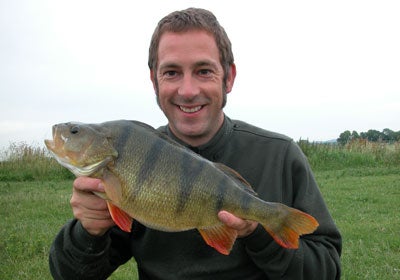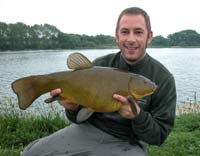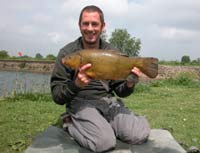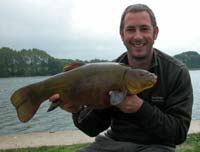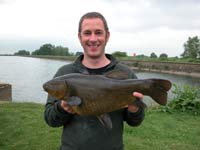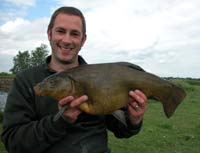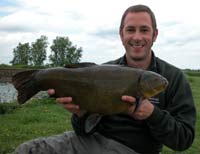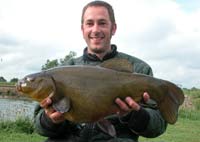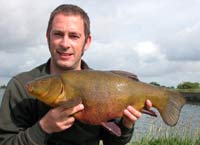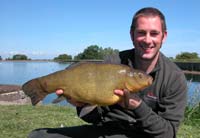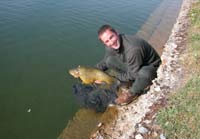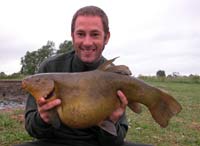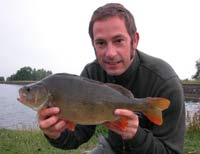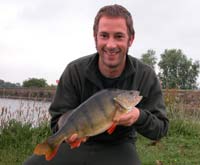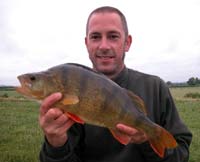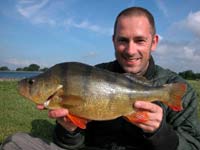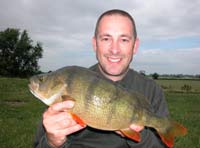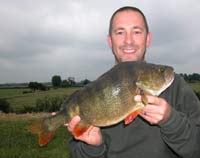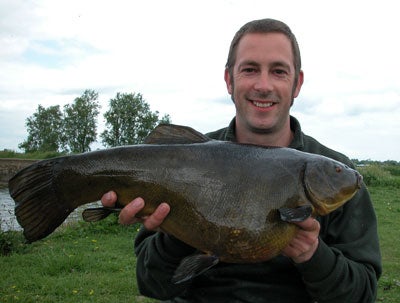  |
Wilstone Reservoir has deservedly earned a reputation as being a very hard water and there is no doubt that it can be extremely difficult and frustrating to fish. The reason the fish are so elusive is in part due to the massive amount of natural food in the water but more significantly the fact that two thirds of the bank and virtually all of the access to shallow water in the reservoir falls within a nature reserve that is out of bounds to anglers. Wilstone was originally three reservoirs each named after the nearest villages these being Little Tring, Drayton Beauchamp and Wilstone. Only parts of what were Wilstone and Little Tring can be fished with Drayton falling within the nature reserve.
Damsel flies gave the game away Typically for Wilstone very few fish showed whilst I was fishing and in the whole of June I saw only two fish roll over my baited area. Indeed the only indication that the fish were about to move into the area I was fishing was a drop in pressure and temperature following a hot spell in the last week of May, and the appearance of the first Damsel Flies of the year. Such a change usually leads to the fish moving out of Drayton and into Little Tring and Wilstone to feed before spawning and this is often the only time in May and June that they are close enough to the fishable banks to be caught. Although the fish will usually make the migration every year they usually disappear as soon as soon as they are ready to spawn and in hot years their stay may only be a matter of days.
Bait Realising that the fish were on the move and that they might well arrive in the next twenty-four hours I decided to take a gamble and bait very heavily. Groundbait was to consist mainly of maggot and caster which would be fed in large quantities to wean the fish from their preoccupation with caddis, bloodworm and damsel. In total I put in two gallons of maggots and four pints of casters.
Tackle
Three markers were used to identify the baited area which I groundbaited each day with the aid of my trusty old Sportyak. The entire area for 10 yards in front of the markers was laced with maggots and over the top of this casters were spread over much more confined areas. The aim was to create hotspots where the tench would preferentially feed on the casters so that I could target these and hopefully reduce the amount of time it took the tench to find and pick up my hookbaits.
One of the spots immediately to the left of my middle marker has a slight depression in the bottom of approximately 6 feet in diameter. This feature produced 70% of all my fish. Hitting this spot at 80 yards range in high winds it often took four or more attempts, but there is no doubt that persisting until I landed it spot-on resulted in a lot of extra fish. Indeed, on several occasions I recast to the spot having just taken a fish and had another run in less than two minutes. The repeated casting to achieve the right spot can also have a beneficial effect since tench are curious fish and the noise created by frequent casting even when using a lead rather than a feeder can, and often does, attract tench. A big ‘nine’ and a double and the anticipation is exciting
The next morning I caught two fish but a clear sky ended the feeding spell early. The two fish weighed 7lb 15oz and 7lb 5oz 8dr, with the latter being a male fish. Still assuming that I had a lot of fish in front of me I decided to bait heavily again and introduced the same quantity as the day before.
Huge haul of heavyweights My catch over these three days included 10 eights, 5 nines and a ten, with the individual weights of the fish being as follows: 4th June 2003: 6lb 1oz, 7lb 2oz, 7lb 12oz, 8lb 0oz 8dr, 8lb 1oz, 8lb 5oz, 9lb 11oz 8dr The weekend again saw sunnier weather and this slowed the sport dramatically with an 8lb 12oz on Saturday, a 9lb 3oz on Sunday and nothing on the Monday.
On Wednesday the weather at dawn was perfect and I expected to catch but again the fishing was ended early by bright sunshine and I caught only two fish. However this was no ordinary brace as it was made up of a female of 10lb 12oz* and a male of 7lb 11oz with the male being a new personal best by 4oz.* Subsequent inspection of the photographs showed that this fish was the same fish that I had captured 9 days earlier at 10 lb 5 oz and that this was the only recapture amongst all of the fish over 9lb in weight. The water temperature had now been over 68F for more than two weeks and the only thing that seemed to be stopping the fish from spawning was the lack of weed. Friday the 13th wasn’t so bad The 12th June saw a single fish caught of 7lb 11oz but the weather was about to change again and the next day the fish were to return in numbers.
The next two days were again very hot and sunny but I did manage one fish on Sunday 15th on a hot, sunny and flat calm morning and it was another cracking fish of 10lb 8oz. The weather now got even hotter on Monday and Tuesday and I blanked on both days. It was clear that the fishing would soon be over as the fish moved onto the shallows to spawn. On Wednesday the weather had turned cooler and I caught a very pretty fish which although large-framed and 24 inches long weighed only 8lb 7oz and appeared to be spawned out. I wondered whether the fish had been spawning on Monday and Tuesday but had stopped because of a change in the weather. Either way it was clear that the next few days were likely to see the early season Wilstone tenching for 2003 come to an end. One run, but it’s a PB
I made myself a cup of tea and, wearing a huge grin, sat in the June sunshine admiring the splendid panorama across the reservoir. In total, over a period of 17 days, I had taken 50 fish including 9 nines and 6 doubles and I had beaten my personal bests for both female and male tench. My top 15 fish had an aggregate weight of 150lbs 12oz 8dr, ie, over 10lbs average. What a great way to celebrate the Silver Anniversary of my first tench. Just a week after catching my new PB tench Wilstone was a very different beast
Fishing to a hole in the weed at a range of 70 yards in 13 feet of water I hooked and lost a fish early on Thursday morning but it was not until that evening that I realised its significance. Initially I had cursed myself for losing a big tench but suddenly the obvious dawned on me; the jagged nature of the fight, the hooklink parting 3-4 inches above the hook and the lack of slime on my line were all shouting one thing: I had lost a big perch.
Enter the perch
I coaxed the fish out of one clump of weed after another and, as she finally came into sight, it was clear that I was attached to a very big perch indeed. As she came alongside I managed to sweep her into the net at the first attempt and placing her on my unhooking mat drew back the folds of the net to reveal a huge, very pretty, immaculate but lightly striped Perch. Had she been a tench I could probably have guessed her weight to within a couple of ounces but she was far lighter than any fish I had caught for the last couple of months and I was unsure whether my eyes were deceiving me because she looked well over four pounds. I measured her at 19 inches and then weighed her on both of my sets of scales confirming her weight at a massive 4lb 5oz.
A single bleep signalled the capture of my second best perch It was a warm morning and I thought wrongly that the sun had probably ended sport when a single bleep from the same rod caused me to jump up. The tip twitched slightly and I lifted the rod smoothly to feel the jagged thuds of a big perch at the other end of the line. The fight again involved the fish repeatedly burying itself in clumps of weed and me coaxing it out. As it came free of the clump closest to me the fish kited to my left and in the early morning sunshine it was a stunning sight with its vivid stripes and raised dorsal fin as it powered to my left only a couple of feet below the surface in the gin-clear water. She was clearly a very big fish and with my heart in my mouth she continued to fight every inch to the waiting net.
I had nothing on Sunday, but Monday, the last day of June, saw me have one more bite and my fourth perch of the year. Incredibly it was also my fourth ‘four’ at 4lb 2oz. A rig change and more lobs rekindles the interest
This meant going out lobbing at night for up to two hours at a time and when it didn’t rain it also meant watering the area with the only means available: buckets of water from the reservoir. Watering and collecting was taking me upwards of 21/2 hours a night and I then had to hover over the rods from dawn until 9am as the bites on 9 inch hooklinks tend to be very quick indeed. I would use longer hooklinks but to do so would risk deep hooking a fish and that was a risk I was not prepared to take. On Thursday morning I had two runs with the first screaming off only for me to strike into thin air. I decided to fish a half lob instead and this also had the advantage that I could dispense with the PVA and simply cast the baits. That first half lob was taken within a couple of hours and I landed another huge and beautifully marked perch 18 1/2 inches long and 4lb 6oz.
Second brace of ‘fours’ in a week The next morning I took a fish of 4lb 1oz early on, before the sun broke through. Around midday I was getting ready to leave when it began to cloud over and the breeze picked up. I was checking the time at 12.14pm when there was a single bleep from my right hand rod. I hovered over the rod and as the tip twitched I lifted into a fish which fought extremely hard all the way to the net. Another tremendous fish and again 18 1/2 inches. She went 4lb 5oz, my sixth ‘four’ and my second brace of fours in a week. I decided to fish on and an hour later had another run, this resulting in another lovely fish which although big was clearly my smallest fish and the scales confirmed this with her weighing 3lb 13oz.
Matt joins the fun That evening my youngest son Matt (13) joined me and I put him in the spot that had produced all the bites that morning with me fishing immediately to his left. Fish were rolling everywhere on the reservoir and things were looking good for the next morning. At dawn I lost a good fish on my right hand rod when the hook pulled and then had a number of plucks and pulls which, when struck, resulted in nothing. Matt also had one indication. Eventually I connected with one of the plucks and landed a lovely little female tench of 5lb 13oz. An hour later I got a decent bite and after another excellent fight I landed an older looking fish which turned out to be my 7th ‘four’ in 8 days*, and my 8th ‘four’ of 2003, Matt doing the honours with the scales, recording a weight of 4lb 2oz. An hour later I was in again on the same rod but this fish fought higher in the water and charged around the swim much faster than my previous fish. As Matt netted her we could see she was a much smaller and the scales confirmed a weight of 3lb 3oz for a length of 161/2 inches. I recast the rod and hooked a fish on the drop which was even smaller at 2lb 2oz.
That day it got very hot and the next morning the change in temperature had clearly had an effect as both Matt and I had no indication at all. That pattern continued over the next couple of sessions with only two fish of 2lb 2oz and approx 1 lb 8 oz. It was time to move on to other things. First reported catch in ten years This is the first catch I have reported in ten years with a significant part of the reason for my previous silence being to avoid the pathetic behaviour of jealous anglers who should know better. Sadly, over the last few weeks I have had to put up with a considerable amount of hassle caused by those who have been taken over by the green eyed monster and it has already cost me at least one big fish. In my opinion a true big fish angler fishes for fun, admires big fish for the beautiful creatures they are, regardless of who catches them, and sees the success of others as another opportunity to learn. Andy Nellist, ‘The Dog’, July 2003 |










